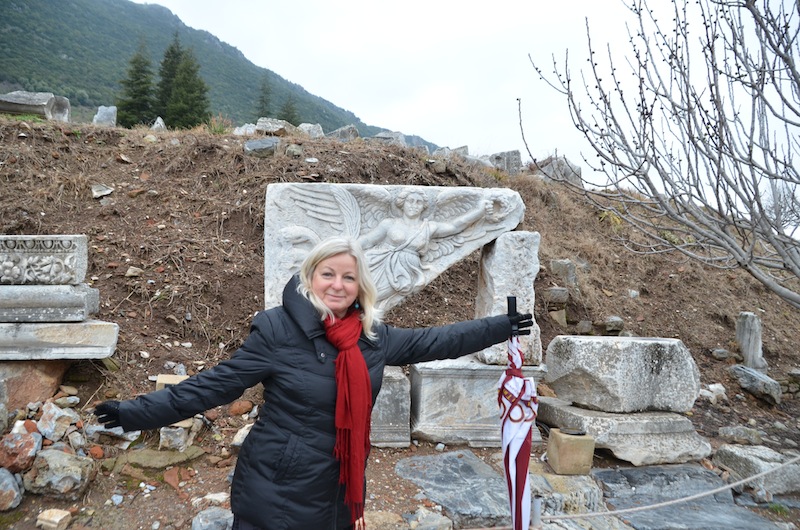
“Give me a word, any word, and I show you that the root of that word is Greek.”
Gus Portokalos, “My Big Fat Greek Wedding”.
May my Turkish friends forgive the above quote from a film about a charming Greek family living in the US, but I was repeatedly reminded of its meaning after visiting Turkey in March of 2012.
Our 3500 km journey around the country started in Istanbul, then took us to the battlefields of Gallipoli, across the Dardanelles to the ruins of Troy, Pergamum, Kusadasi, mineral springs of Pamukkale, the prosperous resort town of Antalya, whirling dervishes of Konya, the magical volcanic valleys of Cappadocia, Ankara and back to Istanbul. Not to mention dozens of equally significant and interesting stops along the way…
This was my third trip to Turkey, but that did not prevent me from being impressed and pleasantly surprised with the endless attractions offered by this country and its friendly people. Of course I liked the Turkish food, but now I was also able to give justice to the wonderful Turkish red wine, especially Shiraz, which could be had in the local supermarkets for about $7 per bottle. In addition to being impressed with the Blue Mosque, St. Sophia and Bosphorus in Istanbul, I was blown away by the views of the snowy Cappadocian hills and caves, as seen from the bird-eye view offered by the hot air balloon flight. The list goes on and on…
However, what really made the difference between this and previous visits were the interesting commentaries provided by our guide, Aydin, as we drove through the Western and Central Anatolia. Whether Aydin meant to say this or not, but the central message of his extremely informative lectures was this – almost everything used by the Western Civilization today was previously invented in the ancient Anatolia – the land occupied by the modern Turkish Republic.
Here is a short list of such staples of our everyday lives:
Parched Paper – During the 2nd century BC people in the region of the Mediterranean began using a much more expensive alternative to papyrus. Tradition credits its invention to Eumenes II, who rules in Pergamum on the west coast of Turkey from 197 to 159 BC. The substance is parchment (the word derives from a variation of Pergamum). It is a form of leather with parchment both sides are treated and rubbed until smooth, to form a flexible double surface.
Flamethrowers – In AD 674 a Muslim fleet attacked Constantinople. It was greeted by a new weapon, which was a precursor of the modern flamethrower. It has never been discovered precisely how the Byzantine chemists achieved the jet of flame for their ‘Greek fire’. Contemporary accounts imply that the inflammable substance is petroleum-based, floats on water, and is almost impossible to extinguish.
Money – The king of Lydia (Western Turkey), Croesus (595 BC – c. 547 BC) is credited with issuing the first true gold coins with a standardized purity for general circulation.
Angora Rabbit, Cat, Goat – All of these animals were initially domesticated near Ankara (Angora) and have inherited the name of the Turkish capital city.
Christian VIP’s – It seems that anyone who was of any importance during the early stages of the Christian Church had some connection with Turkey. Such saints as John, Paul, Peter, Nicholas, George and even Mary (Mother of Jesus) were either born, buried or had spent considerable period of time in Anatolia. Additionally, the ancient city of Antioch (modern-day Antakya) was the place where followers of Jesus were first called Christians.
Tulips – Although tulips are often associated with the Netherlands commercial cultivation of the flower began in the Ottoman Empire.
Vaccination – In 1717, Lady Mary Wortley Montagu learned about variolation (the deliberate infection with smallpox) in Constantinople. In 1721 several British prisoners and abandoned children were inoculated by having smallpox inserted under their skin. When none eventually contracted smallpox, the procedure was deemed safe and members of the royal family were inoculated. The procedure then became fashionable in Europe.
Noah’s Ark – Physical searches for Noah’s Ark continue on and around Mount Ararat in Eastern Turkey, the Ark’s supposed resting place.
First Recorded Manned Flight – Hezarfen Ahmet Celebi flew in the 17th century. Using two wings, he glided off the Galata Tower in Europe and flew over the Bosphorus to land on the Asian side of Istanbul.
Yogurt – The word “yoğurt” is Turkish in origin. Turkish immigrants brought yogurt to N. America in the 1700s but it really didn’t catch on until the 1940s, when it was reintroduced by the company called Dannon in the United States.
True World Map – Piri Reis, an Ottoman admiral, drew the first true world map in 16th century. The map was showing even Antarctica.
Cement – Builders in Greek cities on the coast of Turkey (and in particular Pergamum) evolve cement in about 200 BC as a structural material, in place of weaker mortars such as gypsum plaster (used in Egypt) or bitumen (in Mesopotamia). The secret of the new material is the lime which binds sand, water and clay.
In retrospect, it is not surprising that people who had lived in the region occupied by modern Turkey were so resourceful and inventive. After all, they represented some of the greatest civilizations in our history – Hittites, Greek, Roman, Byzantium, and the Ottoman Empire. Having traveled for 2 weeks around Western and Central Turkey, I am happy to report that their descendants, the modern Turkish people, seem to be doing very well. I sincerely wish them all the best in their continuing journey!
Photo Albums: Hot Air Balloon Over Cappadocia, Turkey Collection
Keep on traveling,
Lenka info@lenkatraveler.com